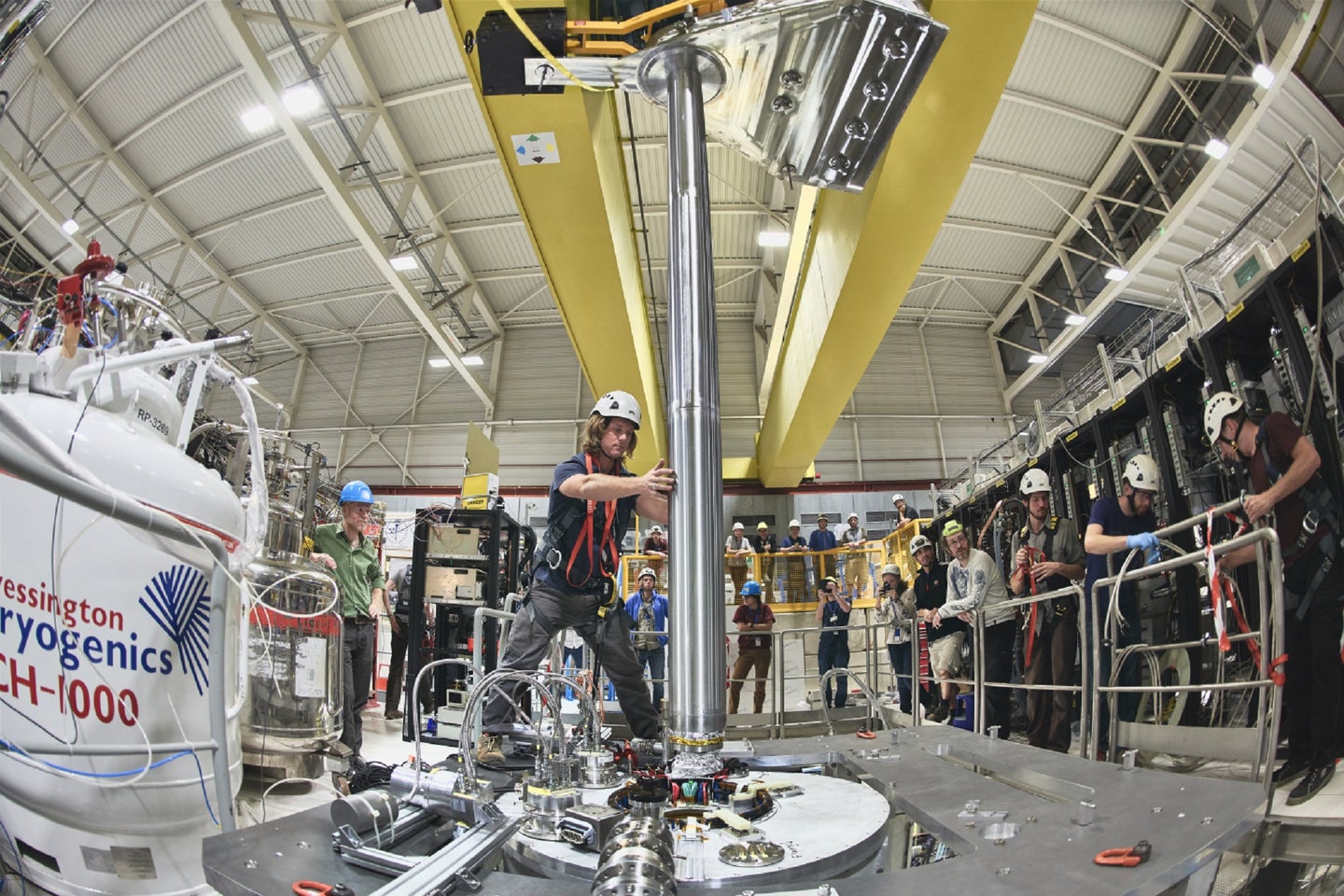Does antimatter fall down or up? We now have a definitive answer.
Gravity wins—this time around.

Albert Einstein didn’t know about the existence of antimatter when he came up with the theory of general relativity, which has governed our understanding of gravity ever since. More than a century later, scientists are still debating how gravity affects antimatter, the elusive mirror versions of the particles that abide within us and around us. In other words, does an antimatter droplet fall down or up?
Common physics wisdom holds that it should fall down. A tenet of general relativity itself known as the weak equivalence principle implies that gravity shouldn’t care whether something is matter or antimatter. At the same time, a small contingent of experts argue that antimatter falling up might explain, for instance, the mystical dark energy that potentially dominates our universe.
As it happens, particle physicists now have the first direct evidence that antimatter falls down. The Antihydrogen Laser Physics Apparatus (ALPHA) collaboration, an international team based at CERN, measured gravity’s impact on antimatter for the first time. The ALPHA group published their work in the journal Nature today.
Every particle in the universe has an antimatter reflection with an identical mass and opposite electrical charge; the inverses are hidden in nature, but have been detected in cosmic rays and used in medical imaging for decades. But actually creating antimatter in any meaningful amount is tricky because as soon as a particle of matter and its antagonist meet, the two self-destruct into pure energy. Therefore, antimatter must be carefully cordoned off from all matter, which makes it extra difficult to drop it or play with it any way.
“Everything about antimatter is challenging,” says Jeffrey Hangst, a physicist at Aarhus University in Denmark and a member of the ALPHA group. “It just really sucks to have to work with it.”
Adding to the challenge, gravity is extremely weak on the microscopic scale of atoms and subatomic particles. As early as the 1960s, physicists first thought about measuring gravity’s effects on positrons, or anti-electrons, which have positive rather than negative electric charge. Alas, that same electric charge makes positrons susceptible to tiny electric fields—and electromagnetism eclipses gravity’s force.
So, to properly test gravity’s influence on antimatter, researchers needed a neutral particle. The only “one of the horizon” was the antihydrogen atom, says Joel Fajans, a physicist at UC Berkeley and another member of the ALPHA group.
Antihydrogen is the first, most fundamental element of the anti-periodic table. Just as the garden-variety hydrogen atom consists of one proton and one electron, the basic antihydrogen atom consists of one negatively charged antiproton and an orbiting positron. Physicists only created antihydrogen atoms in the 1990s; they couldn’t trap and store some until 2010.
“We had to learn how to make it, and then we had to learn how to hold onto it, and then we had to learn how to interact with it, and so on,” says Hangst.
Once they overcame those hurdles, they were finally able to study antihydrogen’s properties—such as its behavior under gravity. For the new paper, the ALPHA group designed a vertical vacuum chamber around a vertical tube devoid of any matter to prevent the antihydrogen from annihilating prematurely. Scientists wrapped part of the tube inside a superconducting magnetic “bottle,” creating a magnetic field that locked the antihydrogen in place until they needed to use it.
Building this apparatus took years on end. “We spent hundreds of hours just studying the magnetic field without using antimatter at all to convince ourselves that we knew what we were doing,” says Hangst. To produce a magnetic field strong enough to hold the antihydrogen, they had to keep the device chilled at -452 degrees Fahrenheit.
The ALPHA group then dialed down the magnetic field to open the top and bottom of the bottle, and let the antihydrogen atoms loose until they crashed into the tube’s wall. They measured where those atomic deaths happened: above or under the position the antimatter was held in. Some 80 percent of atoms fell a few centimeters below the trap, in line with what a cloud of regular hydrogen atoms would do in the same setup. (The other 20 percent simply popped out.)
“It’s been a lot of fun doing the experiment,” Fajans says. “People have been thinking about this problem for a hundred years … we now have a definitive answer.”

For instance, when the authors of the Nature study computed how rapidly the antihydrogen atoms accelerated downward with gravity, they found it was 75 percent of the rate physicists would expect for regular hydrogen atoms. But they expect the discrepancy to fade when they repeat these observations to find a more precise result. “This number and these uncertainties are essentially consistent with our best expectation for what gravity would have looked like in our experiment,” says William Bertsche, a physicist at the University of Manchester and another member of the ALPHA group.
But it’s also possible that gravity influences matter and antimatter in different ways. Such an anomaly would throw the weak equivalence principle—and, by extension, general relativity as a whole—into doubt.
Solving this essential question could lead to more answers around the birth of the universe, too. Antimatter lies at the heart of one of physics’ great unsolved mysteries: Why don’t we see more of it? Our laws of physics clearly decree that the big bang ought to have created equal parts matter and antimatter. If so, the two halves of our cosmos should have self-destructed shortly after birth.
Instead, we observe a universe filled with matter and devoid of discernable antimatter to balance it. Either the big bang created an unexplained glut of matter, or something unknown happened. Scientists call this cosmic riddle the baryogenesis problem.
“Any difference that you find between hydrogen and antihydrogen would be an extremely important clue to the baryogenesis problem,” says Fajans.
